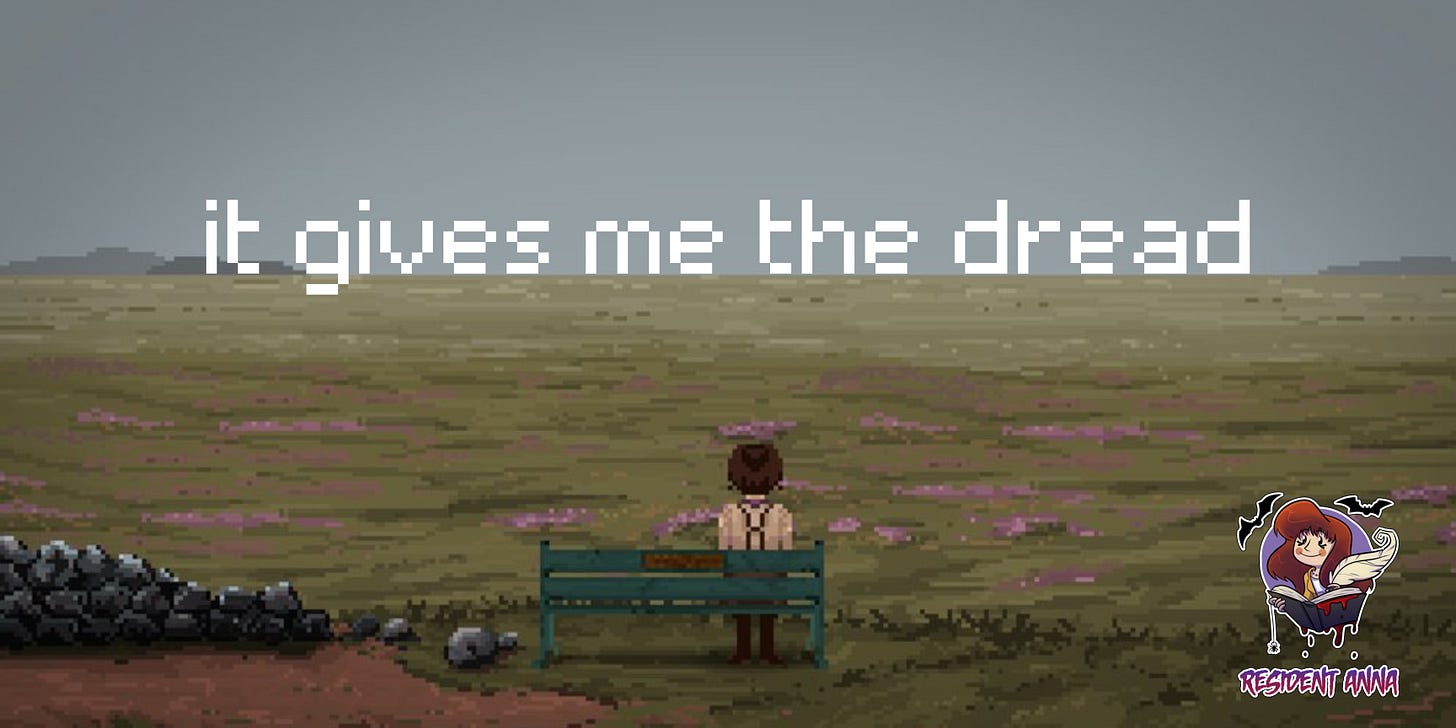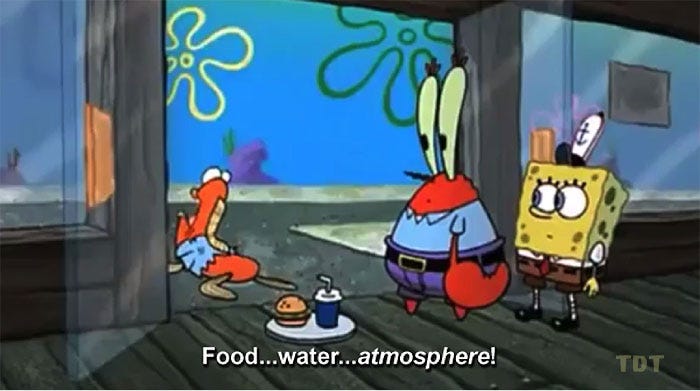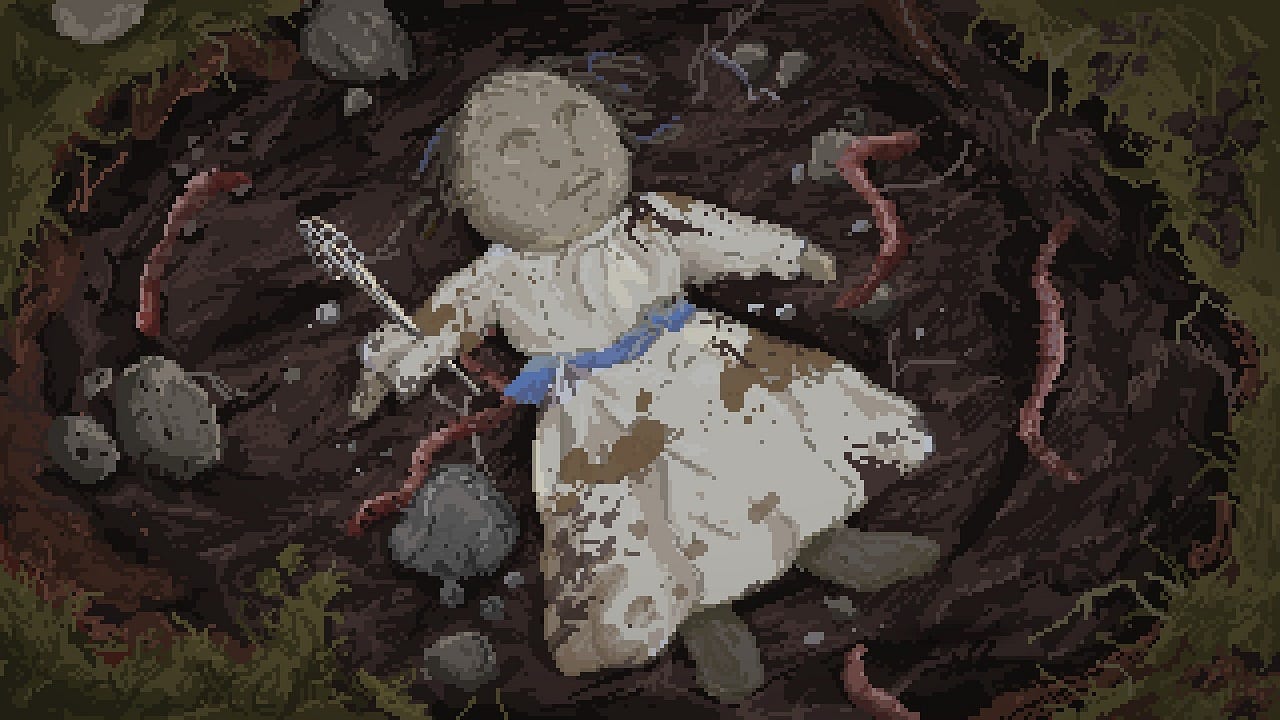It Gives Me the Dread
"What do you look for in a good horror game?" is quite the complicated question, actually.
Welcome to the inaugural post of Resident Anna: a blog about horror games, theory, psychology… whatever! I thought this topic might be a great way to kick things off. Thank you for reading!
Please be aware that this article contains minor spoilers for The Excavation of Hob’s Barrow - I don’t give away too much, I promise!
I love horror games. A lot. And a question I often get is: “what do you look for in a good horror game?” And while my answer to this is naturally very subjective, I arrived at a somewhat unusual response to this question.
Now, if you're like me and you play a lot of horror games and have done so for years... you may find yourself with some degree of tolerance. This is known as habituation, a psychological phenomenon where increased exposure to a particular exciting stimuli eventually decreases the response. This is why many people who regularly engage with horror content can be “hard to scare.”
Once you’ve seen the playbook enough times, you’re almost able to predict when certain scares are going to occur. And while being able to deduce the mechanism of design is critical to anyone who wants to become a designer themselves - I honestly miss how much easier I used to be to scare. Now I’m too focused on the design or the theory of the whole thing.
So when your tolerance is high, when you’ve played the classics and know the tropes, what still makes a game stand out? What still gets your heart racing or palms sweating?
My answer? I like games that “give me the dread.”
The Psychology of Dread
Dread is a very particular type of anxiety. It isn’t necessarily the adrenaline-shot sensation of your heart pounding in your ears. It’s something else.
Merriam-Webster defines “dread” as:
Dread is a fear tinged with awe and trepidation: an anxiety that is slow, not fast. Anticipatory, not reactionary.
And us humans? We hate it.
Multiple studies have reproducibly found that humans are so resistant to experiencing dread that we would literally rather experience an unpleasant electric shock than have to sit with it. Using brain imaging, researchers have found that when given the choice of having an electric shock now (albeit one that was of a greater voltage), or merely wait for a smaller voltage shock to occur, more people chose to get the bigger shock than wait in anticipation.
“A primary motivating force in human nature is to avoid anxiety—unquestionably one of our most distressing emotions. So, when given the opportunity, we’d rather go ahead and process it than be paralyzed by it. If what we fear can’t be avoided, we’ll typically attempt either to short-circuit it (i.e., just get the bad news over with quickly, so we can then hear something more positive), or minimize it (by getting a shock right away rather than add to our trepidation by waiting for it).”
- Leon Seltzer, PhD - “The Fascinating Dynamics of Dread”
Dread pulls the strings of our most basic human neurological impulses. Anxiety is our lizard brain sounding an alarm that we are in danger, and makes its associated sensations so intolerable that we would do just about anything to get away from it. Anxiety is, in itself, a threat that must be neutralized, adding an additional hazard to whatever frightening circumstance we’re already dealing with. Being unable to escape it is one of the worst feelings imaginable. But I don’t need to tell you that.
Anyone alive in the current day is already deeply acquainted with the sensation of dread. Molly Jong-Fast wrote for The Atlantic: “low-level fear seems to have permeated everything these days, like the music you hear in elevators or in airport lounges. It’s the hum of dread, the lullaby of anxiety.” I mean, the Oxford English Dictionary literally made “doomscrolling” its 2020 word of the year. I’m preaching to the choir.
In real life, there is no shortage of dread - its flavors are as many as the modern horrors that are unfortunately very much within our comprehension. In fact, there’s almost a banality to it. It’s commonplace - it’s that constant hum as Jong-Fast described: like an old Frigidaire window unit while you’re trying to sleep.
Yet trying to intentionally replicate such an experience within a game feels strangely inactionable. It’s a sensation we know so well that we can often passively filter it out of our internal monologues… and yet trying to design an experience evoking that feeling is remarkably difficult. So when a game is able to achieve such a feat, it really stands out.
The Narratology of Dread: Feat. The Excavation of Hob’s Barrow
…Now let’s talk video games.
As established above, dread is inherently more atmospheric than its cousins terror, panic, fear, or fright. Rather than a singular moment such as a jumpscare or cinematic, dread consists of an enduring presence. Once the cutscene is over, or the jumpscare has come and gone, the player still feels it it over their shoulder. They are never truly “safe” from the threat - that sense of “impending” and “disagreeable.”
Essentially: the vibe has to be as immaculate as it is rancid.
“Vibes” (sometimes referred to as the much more official sounding “narrative resonance”) are obviously not quantifiable. There is no industry standard as vibes vary from project to project. There is no pipeline for vibes. No vibe QA. Because vibes are ultimately the end result of a convergence of the work of all disciplines (such as art, design, narrative, systems, music… basically everything). The work must seamlessly weave together to create a particular atmosphere - in this case, an uneasy one.
It’s easy to say that all elements must work together to create a singular experience… but the realities of production schedules, cuts, layoffs, and compromises can mean that the overall vibes or resonance of a project may take a hit. Making a game is hard. Making a game with exceptional vibes is even harder. So when a game is able to absolutely nail it, it’s something to really be celebrated.
The Excavation of Hob’s Barrow by Cloak and Dagger Games unexpectedly nabbed my 2022 GOTY in the fourth quarter last year. It’s a classic point-and-click adventure game with a delightfully pixelated art style, brilliant voice acting, and A24 folk-horror vibes all around. And it is a masterclass in dread.
You play as Thomasina Bateman, a plucky, queer-coded Victorian archeologist with a particular interest in barrows of Britain. She has been compiling her research into a book - and word of its publication has caused her to receive a letter from a man by the name of Leonard Shoulder. Mr. Shoulder tells her of a “Hob’s Barrow,” located in the fictional remote town of Bewlay, near the very real town of Bakewell, on the English moors. He invites her to come visit, as he says that she will be able to excavate the barrow if she so desires.
Her curiosity gets the better of her, and Thomasina is off to Bewlay in search of Hob’s Barrow.
It’s the classic Twin Peaks setup: a small, isolated town, an outsider investigating - and no one wants to give a straight answer. Thomasina quickly finds that things are not as they seem, for the Mr. Shoulder she has been corresponding with is nowhere to be found - even though some of the locals confirm that yes, such a man does live in the village.
What’s most peculiar is that some of the locals do not claim to know of a Hob’s Barrow at all, and are openly hostile towards Thomasina as an outsider - not to mention the very train that she came upon.
With the backdrop of the English moors, Hob’s Barrow paints an eerie otherworld. With bleak, flat topography, the constant spitting of rain, and droning, dissonant, but eerily beautiful soundtrack, Cloak and Dagger flawlessly cement Bewlay’s reputation as a “thin place” from the moment Thomasina steps off the train - long before the player hears the dialogue that names it as such.
Those with knowledge of British folklore will also immediately begin to notice things are very much Not Right (or “thin”) in Bewlay. Mushroom “fairy circles.” A crossroads. A cairn. An older “wise woman” (a member of the “cunningfolk”) who lives on the outskirts of town. Stories of a local goblin. All well-researched and threaded into the tapestry of the atmosphere, interspersed with anachronistic (but not out of place) neopaganist elements of the 20th century.
Thomasina, of course, as an antiquarian and woman of science, is not moved by such fairytales. She finds it quaint, but doesn’t share the locals’ sense of superstition. But what she can’t ignore is the hardly supernatural, but very pervasive sense of the uncanny: things that look almost right - but aren’t. Dreams that feel too realThings that logically should be impossible - but here they are. Thomasina’s time in Bewlay is filled with such moments: but I won’t spoil the fun for you.
One of the great tricks that Cloak and Dagger employs during major story beats is a sudden, jarring cut to realistic closeup. You know. Like in Spongebob?
The reason this works is that it’s disarming: the sudden change in art style and typical mode of delivery demands the attention from the viewer. In Hob’s Barrow, this works particularly well because of the art style’s choice of pixilation, which like its art-history cousin of pointillism, paints beautiful imagery via what the viewer sees in aggregate. By cutting to a detailed closeup, the sudden shift feels wrong - especially when it comes to the faces of the people of the town (who were mere pixels moments before). The sense of the uncanny rears its head for a moment… then disappears.
Things are definitely not right in Bewlay.
To make matters worse, as Thomasina slowly begins to befriend a few of the locals, she’s only left with more questions. Hob’s Barrow is real… as are the reasons why the locals are so hush-hush about it. The layers of interpersonal secrecy among the locals of Bewlay, Thomasina’s own mysterious past, and the rich folklore and uncanniness of the moorlands create a downright oppressive sense of dread that grows from the very start to reach a crescendo in the final moments.
And the pacing? It’s slow. In fact, though it received favorable reviews post-launch (PC Gamer, Rock Paper Shotgun, Eurogamer), the slow burn of the narrative was frequently sighted by critics as a sticking point. Consequently, the pace makes the shock of the ending seem rushed by comparison. But if you can stick it out and jive with the vibes, it’s a fantastic ride filled with dread doesn’t lift until the credits roll.
But after all that talk of anticipation and impending doom, it’s important not to forget the secondary definition of dread. It’s that sense of awe: both stunning and frightening in such a way that you can’t tear your eyes away from it. And Cloak and Dagger flawlessly captured these dual elements.
Hob’s Barrow is thoughtful. It takes its time.
And most importantly, no matter how much your lizard brain might be yelling at you to get out of there or get it over with: it doesn’t let up.
Other Games That “Give Me The Dread”:
Scratches: Director’s Cut: a point and click game (also set in England but made by Argentinian developers) where the real horror is colonialism! This one actually isn’t available on most platforms anymore due to licensing issues, so the link is to a YouTube longplay sans-commentary. The dread is real in this one.
The Path: growing up as a young woman sure is a trip! :)))
Alien: Isolation: don’t play this one if you’re trying to keep your blood pressure down. This one is distinctly the most outright stressful horror game I have ever played. Content warnings for gore.
Iron Lung: the only thing scarier than the deep ocean is the prison industrial system (but more on that from me later)! Recently announced to be made into a movie starring Markiplier???
Five Nights at Freddy’s Sister Location: you didn’t think I was going to create a list about dread and not include this one, right? This spinoff of the main series asks terrifying questions like: do robots want to do what we want them to do? You don’t need any greater knowledge of the series for this one too, which is nice. While there is no explicit gore, the content is still disturbing.
Spooky’s Jumpscare Mansion: just play it. Don’t think about it. Just play it. It’s changed a lot over the years, but is still iconic. Did I mention it’s free?????
The Last Door: Collector’s Edition: this was actually used as a reference for Hob’s Barrow. This multi-episode series has some really creative puzzle design. Content warnings for suicide and suicidality.











